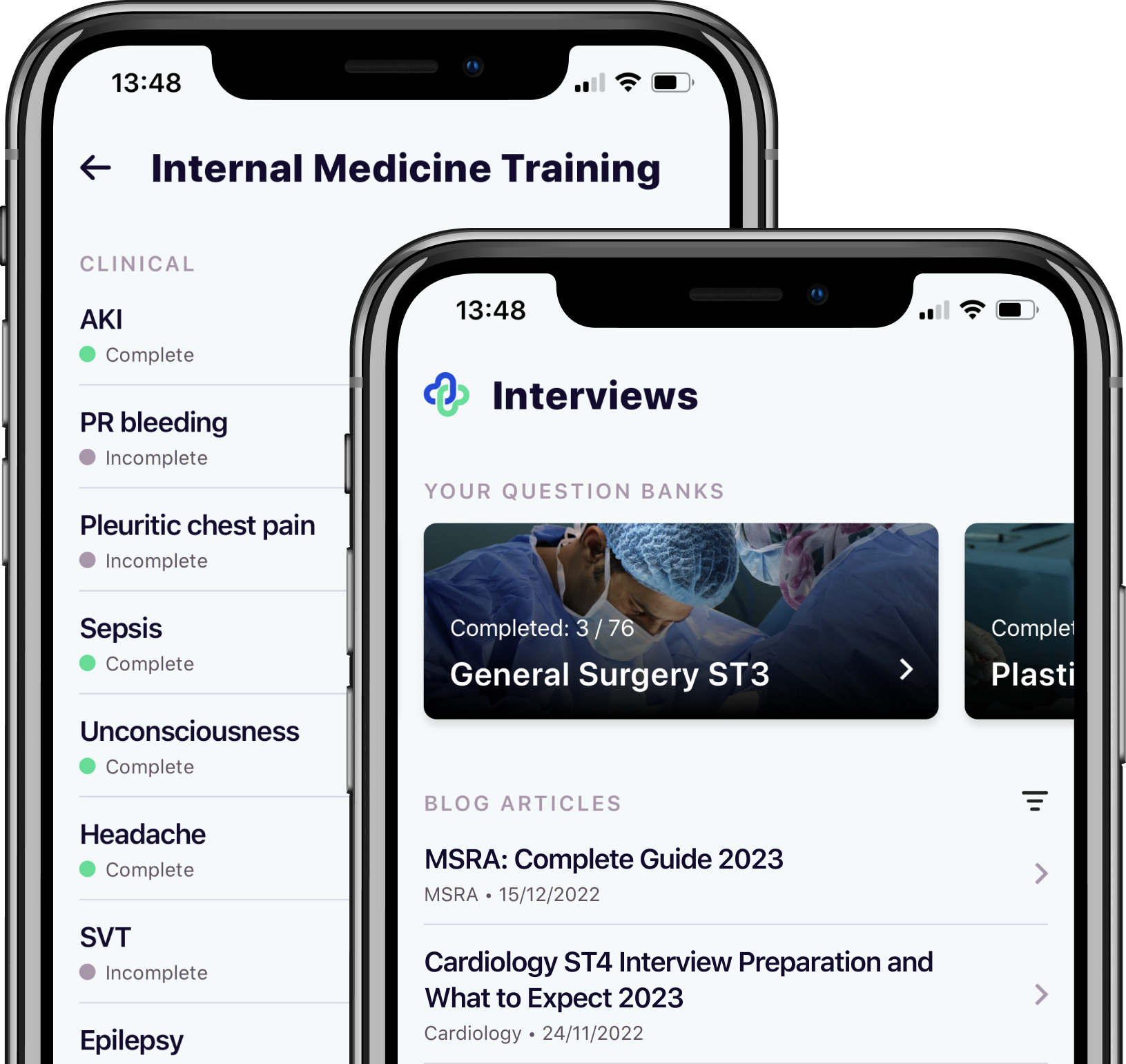
SJTs: A Complete Guide for the UKFPO
If you’re applying to the UK Foundation Programme (UKFPO) for 2024 entry, including the Specialised Foundation Programme (SFP) and Foundation Priority Programme (FFP), you’re no longer required to complete the Situational Judgement Test (SJT). This simple guide provides all the key information for applying, preparing and undertaking the SJT for 2023 UKFPO entry.
For 2024 entry onwards, the UK Foundation Programme has introduced a new Preference Informed Allocation (PIA), which removes the need to sit the SJT. You can find more information about the new PIA model which uses computer-generated ranking in our Foundation Job Ranking blog. This SJT blog is for reference only.
Do you need to take the UKMLA?
Our new UKMLA question bank, designed specifically to match the exam syllabus, can help!
The UKMLA syllabus differs from old-style medical finals or the PLAB.
Ensure that any question bank provider you use hasn’t just changed the name of their old question bank. Medicine is vast, and you may waste considerable time revising topics not in the MLA.
All providers should be able to give you a breakdown of exactly how their question bank matches the UKMLA content map. Find ours here.
UK Foundation Programme Application – SJT
The SJT is a vital element of your UKFPO application. To give you an idea of how it fits into your UKFPO application, the following is a brief overview of the process:
- Complete your eligibility application form (if applicable)
- Register on Oriel
- Complete the national application form, including ranking your foundation school preferences (you can find more information in our Foundation Job Ranking Guide).
- Complete the SJT
- Rank the foundation jobs within your allocated foundation school in order of preference
You can find more information about the UKFPO, including a further breakdown of the application process, timeline and key dates, in our UK Foundation Programme Office (UKFPO): Overview 2024.
You’ll notice above, there’s two stages of ranking, as you first rank your foundation school preferences then the foundation jobs. The SJT is an important element of your UKFPO application as, together with your Educational Performance Measure (EPM) score, it makes up your Foundation Programme Application System (FPAS) points.
FPAS calculator
EPM and SJT scores are combined to give every applicant a ranking. Your FPAS points – and subsequent ranking – determine how likely you are to be matched with your chosen foundation school and foundation job.
Foundation schools and foundation jobs are allocated in rank order, with higher scoring FPAS applicants given priority. You can find out more about foundation school and foundation job allocation, as well as advice on how to rank your preferences, in our Foundation Job Ranking Guide.
If you want to get an idea of the foundation schools and the types of UKFPO jobs that have been offered previously, visit our Foundation Job Ranker to view the 2023 options. There you’ll also find the 2024 jobs once they have been released by Oriel.
Format of the SJT Test
The SJT consists of two exam sections, totalling 2 hours 20 minutes of exam time, with additional mandatory and optional sections to complete.
The format of the SJT is as follows:
| Section | Explanation | Time |
|---|---|---|
| A non-disclosure agreement (NDA) | Mandatory – you must complete the NDA before you can start the exam | Untimed |
| Tutorial | Optional – helps you to understand the basic functionality of the computer-based exam | 5 minutes |
| SJT section 1 | Typically 37 scenarios – 19 multiple choice and 18 rating scenarios – each with several related questions | 70 minutes |
| Comfort break | Optional | 10 minutes |
| SJT section 2 | Typically 38 ranking scenarios, each with several related questions | 70 minutes |
| Survey | Optional – allows you to give feedback if you wish | 10 minutes |
In each section, you’ll be given a series of work-related scenarios and asked questions about how you would respond in each situation. As you can see in the table, there are three different scenarios / questions types, these are:
- Multiple choice – you’re required to select three answers from a possible eight, which when applied together, will address the situation given.
- Rating questions – you’ll be given five possible responses to the scenario, which you need to rank in order of importance or appropriateness.
- Ranking questions – you’ll be given between four and eight responses to the scenario, each of which you must individually rate (between 1–4) the importance or appropriateness of the response.
Registering for your SJT
For 2023 UKFPO entry, the SJT booking windows are as follows:
| Applicant type | Dates |
|---|---|
| For applicants with approved reasonable adjustments | 3 – 7 October 2022 (12 midday BST) |
| For all applicants | 10 – 13 October 2022 (12 midday BST) |
When should I take my SJT?
Two-week testing windows for the SJT are offered twice per year (December and January). The UKFPO states that there is no advantage in taking the exam in either December or January; it is simply down to which testing window is more suitable for you.
For 2023 UKFPO entry, the SJT testing windows are as follows:
| Exam window | Dates |
|---|---|
| SJT window 1 | 7 – 20 December 2022 |
| SJT window 2 | 19 – 23 January 2023 |
What should I bring to my SJT?
The SJT is a computer-based test, delivered in Pearson VUE test centres or remotely (see below). For the exam, you’re required to take one form of original, valid government issued identification; you can find a list of accepted IDs here.
You’re not permitted to take any form of notes into the exam, this includes having a notebook or paper, whether undertaking the exam in a test centre or remotely. You’ll be provided with a physical or online whiteboard for making notes, depending on where you complete the exam.
How should I prepare for my SJT?
Although the scenarios are clinical based, the SJT is not designed to test your medical knowledge, rather it assesses the essential competencies outlined in the national Person Specification. The SJT focuses on the attributes needed to work as a doctor, including, among other things, the ability to:
- Prioritise tasks
- Make decisions
- Work effectively with works
- Communication effectively with patients and colleagues
- Deal with pressure
The GMC’s Good Medical Practice is a useful document for helping you to prepare for the SJT. The exam is looking for you to demonstrate appropriate professional behaviour, as set out in the Good Medical Practice guidance, and therefore it’s essential that you familiarise yourself with it.
Completing SJT practice questions will also help you to effectively prepare for the exam.
SJT Practice
To get the most out of SJT practice questions, ensure that you pay close attention to the feedback / explanations, as these provide insight into the reasoning behind the answers given, and will help you to identify where you are potentially dropping marks. Likewise, you don’t want to miss marks for simply running out of time in the exam, so practice completing the number of questions in the allocated time.
The UKFPO provides SJT practice questions here.
Remote SJT
As mentioned previously, you have the option to take the SJT at a Pearson VUE test centre or remotely using OnVUE. If you choose to take the exam remotely, you’ll be monitored by an online invigilator throughout, and must meet strict guidelines. Therefore, it’s important that you read all guidance relating to OnVUE, to ensure that you can follow the guidelines. You can find out more here.
How is the SJT scored?
As mentioned in the SJT format section above, the exam is made up of three different question types: multiple choice, rating questions and ranking questions. The following is an overview of the marks available for each:
| Maximum marks available per response | Responses per scenario | Maximum marks available per scenario | |
|---|---|---|---|
| Multiple choice | 4 | Chose 3 of 8 | 12 |
| Rating questions | 4 | Rate between 4-8 | Up to 32 (depending on number of responses within each scenario) |
| Ranking questions | 4 | Rank 5 | 20 |
It is worth noting that there is no negative marking and marks are available for ‘near-misses’ – meaning you can pick up marks for being close to the correct answer – therefore, it is worth attempting all questions even if you’re unsure.
The SJT uses ‘test-equating’ which takes into account small differences in difficulty between SJT papers and places all marks on the same scale. Therefore, the raw mark you achieve for the SJT will be converted into a scale score between 0 – 50.
What is a good SJT score?
The UKFPO provides a breakdown of previous scores, including the average, maximum and minimum score per medical school, which you can access here (page 24). Currently, the data goes up to 2020, but you’ll find any updates on the UKFPO website here.
You’ll see from the table that the maximum scores for all medical schools in 2020 was 44 or above. Of course, this will be combined with each applicant’s EPM score – which can range between 41 – 50 – and therefore could give a wider range of scores. However, a high score in the SJT will significantly help to boost your chances of ranking higher.
As well as paying attention to the maximum scores and how this will potentially affect your ranking, it is worth noting that you can achieve what is classed as an ‘exceptionally low score’. If this happens, you’ll have an opportunity to attend a review. If you are successful at the review your application will be progressed, however, if you’re unsuccessful your application will be withdrawn from the process. The UKFPO provides more information about what happens if you get a low SJT score here, as well as figures from the exceptionally low scoring SJT reviews in 2020 here.
The UK Foundation Programme Office (UKFPO) recently disclosed that there was an unintended early release of Situational Judgement Test (SJT) scores to applicants. This mistake occurred prior to the official release date. The UKFPO acknowledges that the SJT score carries a significant weight in an applicant’s overall score for the Foundation Programme, and they would like to reassure all candidates that the early release of SJT scores will not impact their allocation to a Foundation School or programme. Eligible applicants can expect to receive information on their allocation to a Foundation School on March 9, 2023, as planned. The UKFPO guarantees that all eligible applicants receive a place on the UK Foundation Programme for the year 2023.
How is my SJT score used?
As mentioned previously, your SJT and EPM scores are combined to give you a ranking. Foundation schools and foundation jobs are then allocated to applicants in rank order; meaning the higher you score the more likely you are to be given one of your top preferences for foundation school and foundation job.
For more information and advice about foundation school and foundation job ranking, visit our Foundation Job Ranking Guide and our Foundation Job ranker, which does the hard work for you. Or, if it’s more information on the UKFPO you need, our UK Foundation Programme Office (UKFPO): Overview 2024 has you covered.

Take your subscriptions with you
Our mobile app allows you to access your interview and exam question banks wherever you are.




